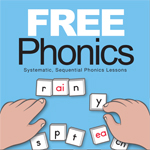Primary Concepts used to offer a free download of their Primary Concepts FREE Phonics guidebook. They no longer offer the free download, but they do sell a printed book that still has "free" in the title. This 104-page book lays out a phonics program for students who can already recognize the sounds of the letters and identify beginning and ending consonants. It seems to be just right for most first graders.
It begins with short-vowel words, then moves on to blends such as nt and nd, the final silent-e pattern, consonant digraphs, consonant pairs, long-vowel pairs, other vowel pairs such as oy and ou. It does not cover all vowel pairs; missing are a few advanced pairs such as au and some sounds of ou. On the other hand, it includes suffixes like ed and ing.
In addition to some words formed with suffixes, the book also presents a few two-syllable words in optional extended lessons, presenting only words that have the phonetic element taught within that lesson. For example, the lesson that teaches the oy sound uses words like boy, toy, and joy in the main lesson. The extension adds enjoy, annoy, voyage, and royal for students ready to tackle more advanced words.
Alphabet letter tiles are used for teaching the lessons. In addition to both upper- and lower-case letters, there are also tiles for letter pairs. Vowels are red and consonants are black so that children learn to easily differentiate vowels. Pages at the back of Primary Concepts FREE Phonics for creating your own tiles can be copied onto cardstock or other sturdy paper. However, you might want to purchase either plastic or magnetic tiles from Primary Concepts. They also sell a storage container that keeps all of your plastic tiles separate. Magnetic tiles can be organized on a magnetic board.
Plastic tiles are used on a Word Building Mat. A reproducible page at the back can be used for this; laminating it will allow you to use it over and over again. Magnetic tiles can be used on your own magnetic board.
A free web-based demonstration app can be used to present the word-building-with-tiles portion of the lessons, although I think this would be most useful for a classroom. A homeschooling parent can easily sit next to a child and show them how to form words, then allow the child to do so by himself.
For each lesson, you will select out only the tiles needed for that lesson. Phonics is taught in word families, so children will usually be changing only one or two elements around the phonogram being taught in each lesson through the first part of the book. For example, when they learn short-o, they build the words fox, box, bop, hop, hops, pot, top, hop, hot, pot, and pots, generally following this progression of changing just one or two letters each time.
Children also write words for each new phonics pattern either in a journal or on forms provided at the back of the book. You can reproduce these forms and compile them into a binder as students complete each lesson.
Each of the eight sections of lessons concludes with a one-page assessment. This is a reproducible page that looks like a typical phonics worksheet where children fill in the blanks, so it is not at all intimidating.
Children definitely need additional practice reading words with the phonetic concepts taught in these lessons, and Primary Concepts FREE Phonics recommends the Tales and Tiles Phonics Readers series (also from Primary Concepts) for this purpose. While other readers such as some of the Bob Books should also work well, Primary Concepts FREE Phonics lists a particular story from the Tales and Tiles Phonics Readers at the end of most lessons.
Primary Concepts FREE Phonics offers a very effective way to present multi-sensory phonics instruction. I was very pleased to discover that while you can purchase companion resources such as tiles and readers from Primary Concepts, you can use the program without doing so.








